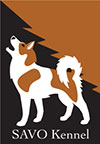Canadian Kennel Club Official Breed Standards
GROUP II HOUNDS II-18 Norrbottenspets
Origin
Sweden
General Appearance
Small, squarish spitz dog, tightly built, with dry, powerful muscles. The dog should be of a very good structure, the head carried high and fearless. The dog should be extremely mobile. Differences in body structure due to sex should be well marked. Norrbottenspets should, as a hunting dog, be attentive and daring, giving impression of alertness, activity, kindness and self confidence. Never nervous, shy or aggressive. The ideal dog should give the impression of a typical, small spitz dog, very alert and attentive, with good anatomy and mentality.
Head
The head should be powerful, dry, well built and viewed from front and side wedge formed. The muzzle moderately long, sharply tapering. The length, half length of head or shorter. The skull moderately wide, stop well but moderately marked, the forehead slightly arched and the skull moderately flat. The superciliary arches should be well marked and the nosebridge straight. The nose should be black and the lips thin, dry and tight fitting. Mouth: Scissor bite with well developed teeth. Eyes: The eyes moderately big, bright and expression calm and energetic. Dark brown. The eyes should be almond shaped and obliquely set. Ears: High set, slightly over medium size and stiffly erect. Tips slightly rounded.
Neck
Moderately long, dry and muscular, with slightly arched neck, carried erect.
Body
Back short, strong, muscular and elastic. Viewed from side, slightly sloping over the withers and then straight. Loins short and broad. Croup moderately long and broad, slightly sloping and with well developed muscles. Chest moderately deep and long, the back ribs well developed. Oval shaped viewed from front. Forechest well developed and well marked. Front of normal width. Viewed from side, the lowest part of chestline should reach the underarm just below the elbow and softly fit into bellyline. Belly moderately tucked up. Depth of body (the vertical distance from highest point of withers to lowest point of chest) should be about half height of withers. January 2004 II-18.1 GROUP II HOUNDS
Fore and Hindquarters
Shoulder blade long and broad, with well developed chest and muscles. Close fitting to chest and proportionately set back.
Upper Arm
Should be the same length as shoulder blade, strong, well fitting close to chest, but permit free movements and form a marked angle with the chest. Elbows directed backwards.
Underarm
Straight, strong bones, dry but flexible muscles. Wrist and pastern Strong. The underarm forming a straight line with wrist and pastern viewed from front. The pastern slightly angled forward viewed from side.
Forefeet
Small, strong, standing straight forward, well arched and closed, with well developed, solid pads.
Croup
Proportionately long, wide and strong, slightly sloping.
Thighs
Proportionately long, forming a straight angle to pelvis. Strong muscles.
Knee joint
Strong.
Lower thigh
Forming a marked angle to upper thigh.
Hock
Broad and strong, viewed from front and side.
Rear pastern
Dry, elastic and rather long.
Hind Feet
As fore feet. Standing straight forward. Hindlegs parallel, viewed from behind.
Tail
Proportionately high set, carried in a fairly high curve, loosely curled with the tip of tail touching side of thigh. The length of tail should not reach below hock. Bobtail not allowed. NORRBOTTENSPETS
Gait
Norrbottenspets should, in canter and trot, show smooth, even movements with great drive, covering the ground well. Topline must be firm. Hindlegs must be parallel.
Coat
Hard, short, straight and rather close fitting hair, fine and dense undercoat. Short on nosebridge, skull, ears and front of legs, longer on neck, back of thighs and underneath the tail.
Colour
All colours permitted. Ideal colour is white with yellow or red/brown markings.
Height
Ideal Height:
Male: 17-1/2-18 inches (45 cm)
Female:16-1/2-17 inches (42 cm)
Faults
Any departure from the foregoing points should be considered a fault and the seriousness of the fault should be in exact proportion to its degree.
